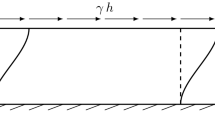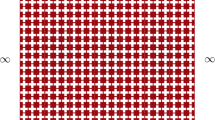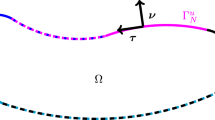Abstract
The present contribution provides a classification of generalized continua constructed by a micromechanical approach, relying on an extension of the Hill macrohomogeneity condition. The virtual power of equilibrium for a micromorphic effective medium is derived from the microscopic Cauchy balance equations, highlighting the classical and higher-order macroscopic stress tensors. The so-called homogeneous displacement associated with the micromorphic effective medium is derived from variational formulations. It allows establishing the extended Hill macrohomogeneity condition that prevails for the micromorphic continuum, wherein the higher-order stress tensors arise as the static variables conjugated to the selected macroscopic degrees of freedom. Suitable projections of the introduced kinematic micromorphic variables into degenerated kinematic variables lead to various subclasses of generalized continua: microstretch, micropolar, couple stress, microdilatation, microstrain, microshear, and strain gradient. An asymptotic ranking of the formulated generalized continua versus a small-scale parameter is formulated in the last part of the paper to quantify their relative importance. The micromorphic homogenization scheme is validated by comparing the predictions of the homogenized response at the macroscale for a double shear test to a reference exact solution. The proposed micromorphic homogenization method remedy most of the limitations of the existing schemes of the literature.











Similar content being viewed by others
References
Alavi, E., Ganghoffer, J.F., Reda, H., Sadighi, M.: Construction of micromorphic continua by homogenization based on variational principles. J. Mech. Phys. Solids 153, 104278 (2021)
Alavi, S.E., Nasimsobhan, M., Ganghoffer, J.F., Sinoimeri, A., Sadighi, M.: Chiral Cosserat model for architected materials constructed by homogenization. Meccanica 56(10), 2547–2574 (2021)
Auffray, N., Bouchet, R., Brechet, Y.: Strain gradient elastic homogenization of bidimensional cellular media. Int. J. Solids Struct. 47(13), 1698–1710 (2010)
Barbagallo, G., Tallarico, D., D’Agostino, M.V., Aivaliotis, A., Neff, P., Madeo, A.: Relaxed micromorphic model of transient wave propagation in anisotropic band-gap metastructures. Int. J. Solids Struct. 162, 148–163 (2019). https://doi.org/10.1016/j.ijsolstr.2018.11.033
Barboura, S., Li, J.: Establishment of strain gradient constitutive relations by using asymptotic analysis and the finite element method for complex periodic microstructures. Int. J. Solids Struct. 136–137, 60–76 (2018). https://doi.org/10.1016/j.ijsolstr.2017.12.003
Berkache, K., Deogekar, S., Goda, I., Ganghoffer, J.F.: Construction of second gradient continuum models for random fibrous networks and analysis of size effects. Compos. Struct. 18, 347–357 (2017)
Biswas, R., Poh, L.H.: A micromorphic computational homogenization framework for heterogeneous materials. J. Mech. Phys. Solids 102, 187–208 (2017). https://doi.org/10.1016/j.jmps.2017.02.012
Biswas, R., Poh, L.H., Shedbale, A.S.: A micromorphic computational homogenization framework for auxetic tetra-chiral structures. J. Mech. Phys. Solids 135, 103801 (2020). https://doi.org/10.1016/j.jmps.2019.103801
Biswas, R., Shedbale, A.S., Poh, L.H.: Nonlinear analyses with a micromorphic computational homogenization framework for composite materials. Comput. Methods Appl. Mech. Eng. 350, 362–395 (2019). https://doi.org/10.1016/j.cma.2019.03.012
Boutin, C.: Microstructural effects in elastic composites. Int. J. Solids Struct. 33, 1023–1051 (1996). https://doi.org/10.1016/0020-7683(95)00089-5
Carlin, M.: Computing geometric moments for objects with an exact polygonal representation (1998)
Cosserat, E., Cosserat, F.: Théorie des Corps déformables. Nature 81, 67–67 (1909). https://doi.org/10.1038/081067a0
De Bellis, M.L., Addessi, D.: A Cosserat based multi-scale model for masonry structures. Int. J. Multiscale Comput. Eng. 9, 543–563 (2011). https://doi.org/10.1615/IntJMultCompEng.2011002758
Eringen, A.C.: Nonlocal Polar Field theories. In: Continuum Physics. Elsevier, pp. 205–267. https://doi.org/10.1016/B978-0-12-240804-5.50009-9 (1976)
Eringen, A.C.: Mechanics of micromorphic continua. In: Mechanics of Generalized Continua. Springer, Berlin, pp. 18–35. https://doi.org/10.1007/978-3-662-30257-6_2 (1968)
Eringen, A.C., Kafadar, C.B.: Part I. Polar field theories. Contin. Phys. 1–73 (1971)
Forest, S.: Micromorphic approach for gradient elasticity, viscoplasticity, and damage. J. Eng. Mech. 135, 117–131 (2009). https://doi.org/10.1061/(ASCE)0733-9399(2009)135:3(117)
Forest, S.: Homogenization methods and mechanics of generalized continua—part 2. Theor. Appl. Mech. 113–144,(2002). https://doi.org/10.2298/TAM0229113F
Forest, S.: Aufbau und Identifikation von Stoffgleichungen für höhere Kontinua mittels Homogenisierungsmethoden. Technische Mechanik. Sci. J. Fund. Appl. Eng. Mech. 19, 297–306 (1999)
Forest, S.: Mechanics of generalized continua: construction by homogenizaton. Le Journal de Physique IV 08, Pr4-39-Pr4-48. https://doi.org/10.1051/jp4:1998405 (1998)
Forest, S., Sab, K.: Cosserat overall modeling of heterogeneous materials. Mech. Res. Commun. 25, 449–454 (1998). https://doi.org/10.1016/S0093-6413(98)00059-7
Forest, S., Pradel, F., Sab, K.: Asymptotic Analysis of Heterogeneous Cosserat Media. Int. J. Solids Struct. 38, 4585–4608 (2001)
Forest, S., Sievert, R.: Nonlinear microstrain theories. Int. J. Solids Struct. 43, 7224–7245 (2006). https://doi.org/10.1016/j.ijsolstr.2006.05.012
Forest, S., Sievert, R.: Elastoviscoplastic constitutive frameworks for generalized continua. Acta Mech. 160, 71–111 (2003). https://doi.org/10.1007/s00707-002-0975-0
Forest, S., Trinh, D.K.: Generalized continua and non-homogeneous boundary conditions in homogenisation methods. ZAMM J. Appl. Math. Mech. / Zeitschrift für Angewandte Mathematik und Mechanik 91, 90–109 (2011). https://doi.org/10.1002/zamm.201000109
Ganghoffer, J.F., Reda, H.: A variational approach of homogenization of heterogeneous materials towards second gradient continua. Mech. Mater. 158, 103743 (2021)
Ganghoffer, J.F., Wazne, A., Reda, H.: Frontiers in homogenization methods towards generalized continua for architected materials. Mech. Res. Commun. 130, 104114 (2023)
Germain, P.: The method of virtual power in continuum mechanics. Part 2: microstructure. SIAM J. Appl. Math. 25, 556–575 (1973). https://doi.org/10.1137/0125053
Germain, Paul: La méthode des puissances virtuelles en mécanique des milieux continus, premiere partie: théorie du second gradient. Journal de mécanique 12, 235–274 (1973)
Goda, I., Ganghoffer, J.F.: Combined bone internal and external remodeling based on Eshelby stress. Int. J. Solids Struct. 94–95, 138–157 (2016)
Gologanu, M., Leblond, J.-B., Perrin, G., Devaux, J.: Recent extensions of Gurson’s model for porous ductile metals. In: Continuum Micromechanics. Springer Vienna, Vienna, pp. 61–130. https://doi.org/10.1007/978-3-7091-2662-2_2 (1997)
Hill, R.: On constitutive macro-variables for heterogeneous solids at finite strain. In: Proceedings of the Royal Society of London. A. Mathematical and Physical Sciences 326, 131–147. https://doi.org/10.1098/rspa.1972.0001 (1972)
Hill, R.: The essential structure of constitutive laws for metal composites and polycrystals. J. Mech. Phys. Solids 15, 79–95 (1967). https://doi.org/10.1016/0022-5096(67)90018-X
Hill, R.: Generalized constitutive relations for incremental deformation of metal crystals by multislip. J. Mech. Phys. Solids 14, 95–102 (1966). https://doi.org/10.1016/0022-5096(66)90040-8
Hill, R.: Elastic properties of reinforced solids: some theoretical principles. J. Mech. Phys. Solids 11, 357–372 (1963). https://doi.org/10.1016/0022-5096(63)90036-X
Howes, F.A., Whitaker, S.: The spatial averaging theorem revisited. Chem. Eng. Sci. 40, 1387–1392 (1985). https://doi.org/10.1016/0009-2509(85)80078-6
Huet, C.: Application of variational concepts to size effects in elastic heterogeneous bodies. J. Mech. Phys. Solids 38(6), 813–841 (1990)
Hütter, G.: On the micro-macro relation for the microdeformation in the homogenization towards micromorphic and micropolar continua. J. Mech. Phys. Solids 127, 62–79 (2019). https://doi.org/10.1016/j.jmps.2019.03.005
Hütter, G.: Micromorphic homogenisation and its application to a model of ductile damage. PAMM 17, 599–600 (2017). https://doi.org/10.1002/pamm.201710269
Hütter, G.: An extended Coleman-Noll procedure for generalized continuum theories. Contin. Mech. Thermodyn. 28, 1935–1941 (2016). https://doi.org/10.1007/s00161-016-0506-1
Hütter, G., Mühlich, U., Kuna, M.: Micromorphic homogenization of a porous medium: elastic behavior and quasi-brittle damage. Contin. Mech. Thermodyn. 27, 1059–1072 (2015). https://doi.org/10.1007/s00161-014-0402-5
Jänicke, R., Diebels, S., Sehlhorst, H.-G., Düster, A.: Two-scale modelling of micromorphic continua. Contin. Mech. Thermodyn. 21, 297–315 (2009). https://doi.org/10.1007/s00161-009-0114-4
Jänicke, R., Steeb, H.: Minimal loading conditions for higher-order numerical homogenisation schemes. Arch. Appl. Mech. 82, 1075–1088 (2012). https://doi.org/10.1007/s00419-012-0614-8
Javadi, M., Epstein, M., Asghari, M.: Thermomechanics of material growth and remodeling in uniform bodies based on the micromorphic theory. J. Mech. Phys. Solids 138, 103904 (2020). https://doi.org/10.1016/j.jmps.2020.103904
Ju, X., Mahnken, R.: Goal-oriented h-type adaptive finite elements for micromorphic elastoplasticity. Comput. Methods Appl. Mech. Eng. 351, 297–329 (2019). https://doi.org/10.1016/j.cma.2019.01.031
Kanit, T., Forest, S., Galliet, I., Mounoury, V., Jeulin, D.: Determination of the size of the representative volume element for random composites: statistical and numerical approach. Int. J. Solids Struct. 40(13–14), 3647–3679 (2003)
Kouznetsova, V., Geers, M.G.D., Brekelmans, W.A.M.: Multi-scale constitutive modelling of heterogeneous materials with a gradient-enhanced computational homogenization scheme. Int. J. Numer. Meth. Eng. 54, 1235–1260 (2002). https://doi.org/10.1002/nme.541
Langenfeld, K., Mosler, J.: A micromorphic approach for gradient-enhanced anisotropic ductile damage. Comput. Methods Appl. Mech. Eng. 360, 112717 (2020). https://doi.org/10.1016/j.cma.2019.112717
Li, J.: A micromechanics-based strain gradient damage model for fracture prediction of brittle materials - Part I: homogenization methodology and constitutive relations. Int. J. Solids Struct. 48, 3336–3345 (2011). https://doi.org/10.1016/j.ijsolstr.2011.08.007
Liu, X., Hu, G.: Inclusion problem of microstretch continuum. Int. J. Eng. Sci. 42, 849–860 (2003)
Liu, Y., Zhang, X.: Metamaterials: a new frontier of science and technology. Chem. Soc. Rev. 40, 2494 (2011)
Mandel, J.: Contribution théorique à l’étude de l’écrouissage et des lois de l’écoulement plastique, In: Applied Mechanics. Springer, Berlin, pp. 502–509. https://doi.org/10.1007/978-3-662-29364-5_67 (1966)
Maugin, G.A.: Thermomechanics of Nonlinear Irreversible Behaviors. World Scientific, River Edge (1999)
Maugin, G.A.: Generalized continuum mechanics: What do we mean by that? pp. 3–13. https://doi.org/10.1007/978-1-4419-5695-8_1 (2010)
Maurice, G., Ganghoffer, J.F., Rahali, Y.: Second gradient homogenization of multilayered composites based on the method of oscillating functions. Math. Mech. Solids (2018). https://doi.org/10.1177/1081286518820081
Mindlin, R.D.: Micro-structure in linear elasticity. Arch. Ration. Mech. Anal. 16, 51–78 (1964). https://doi.org/10.1007/BF00248490
Misra, A., Nejadsadeghi, N.: Longitudinal and transverse elastic waves in 1D granular materials modeled as micromorphic continua. Wave Motion 90, 175–195 (2019). https://doi.org/10.1016/j.wavemoti.2019.05.005
Monchiet, V., Auffray, N., Yvonnet, J.: Strain-gradient homogenization: A bridge between the asymptotic expansion and quadratic boundary condition methods. Mech. Mater. 143, 103309 (2020). https://doi.org/10.1016/j.mechmat.2019.103309
Rokoš, O., Ameen, M.M., Peerlings, R.H.J., Geers, M.G.D.: Micromorphic computational homogenization for mechanocal metamaterials with patterning fluctuation fields (2019)
Rokoš, O., Ameen, M.M., Peerlings, R.H.J., Geers, M.G.D.: Extended micromorphic computational homogenization for mechanical metamaterials exhibiting multiple geometric pattern transformations. Extreme Mech. Lett. 37, 100708 (2020). https://doi.org/10.1016/j.eml.2020.100708
Rokoš, Ondřej, Zeman, J., Doškář, M., Krysl, P.: Reduced integration schemes in micromorphic computational homogenization of elastomeric mechanical metamaterials. Adv. Model. Simul. Eng. Sci. 7, 19 (2020). https://doi.org/10.1186/s40323-020-00152-7
Ryś, M., Forest, S., Petryk, H.: A micromorphic crystal plasticity model with the gradient-enhanced incremental hardening law. Int. J. Plast 128, 102655 (2020). https://doi.org/10.1016/j.ijplas.2019.102655
Forest, S.: Mechanics of generalized continua: construction by homogenization. 8, 39–48 (1998)
Smyshlyaev, V.P., Cherednichenko, K.D.: On rigorous derivation of strain gradient effects in the overall behaviour of periodic heterogeneous media. J. Mech. Phys. Solids 48, 1325–1357 (2000). https://doi.org/10.1016/S0022-5096(99)00090-3
Suhubl, E.S., Eringen, A.C.: Nonlinear theory of micro-elastic solids-II. Int. J. Eng. Sci. 2, 389–404 (1964). https://doi.org/10.1016/0020-7225(64)90017-5
Tran, T.-H., Monchiet, V., Bonnet, G.: A micromechanics-based approach for the derivation of constitutive elastic coefficients of strain-gradient mediaTra. Int. J. Solids Struct. 49, 783–792 (2012). https://doi.org/10.1016/j.ijsolstr.2011.11.017
Trinh, D.K.: Méthodes d’homogénéisation d’ordre supérieur pour les matériaux architecturés. Thèse de doctorat de l’Ecole Nationale Supérieure des Mines de Paris (2011)
Trinh, D.K., Janicke, R., Auffray, N., Diebels, S., Forest, S.: Evaluation of generalized continuum substitution models for heterogeneous materials. Int. J. Multiscale Comput. Eng. 10, 527–549 (2012). https://doi.org/10.1615/IntJMultCompEng.2012003105
von Hoegen, M., Skatulla, S., Schröder, J.: A generalized micromorphic approach accounting for variation and dispersion of preferred material directions. Comput. Struct. 232, 105888 (2020). https://doi.org/10.1016/j.compstruc.2017.11.013
Wood, B.D.: Technical note: revisiting the geometric theorems for volume averaging. Adv. Water Resour. 62, 340–352 (2013). https://doi.org/10.1016/j.advwatres.2013.08.012
Xun, F., Hu, G., Huang, Z.: Size-dependence of overall in-plane plasticity for fiber composites. Int. J. Solids Struct., 4113-4730 (2004)
Author information
Authors and Affiliations
Corresponding author
Additional information
Communicated by Andreas Öchsner.
Publisher's Note
Springer Nature remains neutral with regard to jurisdictional claims in published maps and institutional affiliations.
Appendices
Appendix A: determination of the microscopic displacement field for the effective micromorphic continuum
The micro displacement field in Eq. (50) incorporates five unknown coefficients that can be determined from the definitions of Eqs (35)–(37), and (5), and by recoursing to the averaging theorem together with the symmetry properties of the tensors (for centrosymmetric unit cells, \(\left\langle {{\varvec{\underline{\upxi }}}^{n}} \right\rangle _{Y} \) is equal to zero for odd values of the exponent n):
In Eq. (A 1), the first coefficient should be a true constant (independent of the macroscopic coordinate), so by eliminating macroscopic rigid body motions, it is selected to be nil, \(A_{i} \left( {\mathrm{\textbf{x}}} \right) =0\).
It should be noted that the second moment of area tensor \({{\mathop {\textbf{G}}\limits _{\thicksim }}}\) is a diagonal matrix (for a square) [11] which can be written as
where \(G_{2}^{0} \) is a constant depending on the unit cell shape.
Subtracting Eq. (A 2) from Eq. (A 3), leads to the evaluation of the coefficient \({\mathop {\textbf{e}}\limits _{\thicksim }}\) (a fourth-order tensor) as
Implementing the expression in Eq. (A 6), the coefficient \(D_{inkl} \) can be written as
The previous relation has the following tensor format
In Eq. (A 9), \({\mathop {\mathbf {\Upsilon }}\limits _{\approx }} \) is the fourth-order tensor of the higher-order moments of unit cell area, which is defined as
By substituting Eq. (A 9) into Eq. (A 2), the coefficient \({\mathop {\textbf{B}}\limits _{\thicksim }}\) expresses as
which receives the following tensor format
with the second-order tensor \({\mathop {\mathbf {\Gamma }}\limits _{\thicksim }}\) defined in index format as
To facilitate the calculation of the remaining coefficients, the left-hand side in next Eq. (A 12) can be simplified:
where \(G_{4}^{0} \) is a constant related to the fourth and second moment of areas. Using Eqs. (A 1), (A 5), we obtain:
Multiplying Eqs. (A 4) and (A 5) by \(G_{jk} \) and using expression of \(U_{i} \left( {\mathrm{\textbf{x}}} \right) \) from Eq. (A1) assuming no rigid body motion delivers the algebraic system:
Inserting the last relation into Eq. (A 4) leads to
Substituting the coefficients \({\mathop {\textbf{B}}\limits _{\thicksim }}\), \({\mathop {\textbf{C}}\limits _{\simeq }}\), \({\mathop {\textbf{D}}\limits _{\thickapprox }}\), and \({\mathop {\textbf{E}}\limits _{\approxeq }}\) into the previous Eq. (50) gives the total homogenous microscopic displacement as the following fourth-order polynomial expression of the relative microscopic position, expressed successively in the zoomed domain and physical domain versus the small-scale parameter for this last expression:
The displacement term depending on the micro deformation is odd in the micro position. Thus, the stress will be an even function of the micro deformation, which justifies a posteriori the assumption made in section 2.
Appendix B: derivation of a closed form solution for the double shear problem
The boundary value problem to be solved for the effective micromorphic continuum includes the balance of linear momentum and the constitutive law written in Eq. (56), which specializes in the case of centrosymmetric microstructures and in the absence of body forces at the microlevel to:
The micromorphic constitutive law writes in full generality for an orthotropic material symmetry:
The considered BVP has been completely solved in [67] so we indicate the used Ansatz for the displacement and microdeformation and the obtained solution for an orthotropic micromorphic medium. The kinematic variables, the displacement and microdeformation, express versus the sole vetical position as follows:
In which the prime denotes the derivative with respect to the space variable \({\textrm{x}}_{2} \).
The boundary conditions are those of imposed displacement and clamped higher order kinematic conditions, thus it holds the six constraints:
According to the kinematic assumptions in Eq. (B3), the constitutive law in Eq. (B1) takes the form
The solution for the micromorphic shear deformations have been obtained in [67], and write in terms of hyperbolic functions:
with the constants therein \({\textrm{C}}{ }_{2},{\textrm{C}}{ }_{4},{\textrm{C}}{ }_{9}\) expressing from the three remaining boundary conditions:
with \(\upomega _{1}^{2},\upomega _{2}^{2}\) therein the solution (in terms of their square) of the characteristic equation
Rights and permissions
Springer Nature or its licensor (e.g. a society or other partner) holds exclusive rights to this article under a publishing agreement with the author(s) or other rightsholder(s); author self-archiving of the accepted manuscript version of this article is solely governed by the terms of such publishing agreement and applicable law.
About this article
Cite this article
Alavi, S.E., Ganghoffer, J.F., Reda, H. et al. Hierarchy of generalized continua issued from micromorphic medium constructed by homogenization. Continuum Mech. Thermodyn. 35, 2163–2192 (2023). https://doi.org/10.1007/s00161-023-01239-3
Received:
Accepted:
Published:
Issue Date:
DOI: https://doi.org/10.1007/s00161-023-01239-3




